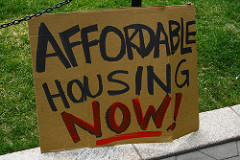Home
Focus Areas
About Us
Support for Affordable Housing Programs
The Federal Housing Finance Agency (FHFA) was established by the Housing and Economic Recovery Act of 2008 (HERA) and is responsible for the supervision, regulation, and housing mission oversight of the 11 Federal Home Loan Banks (FHLBanks, FHL Bank System), the Federal National Mortgage Association (Fannie Mae), and the Federal Home Loan Mortgage Corporation (Freddie Mac). FHFA's mission is to ensure that these regulated entities operate in a safe and sound manner so that they serve as a reliable source of liquidity and funding for housing finance. Since 2008, FHFA has also served as conservator of Fannie Mae and Freddie Mac.

The FHLBanks awarded approximately $322 million in total AHP funds in 2015, helping over 36,000 low - or moderate - income households including about 20,000 very low-income households. Through the CIP, the FHLBanks also funded approximately $3.2 billion in targeted housing and economic development advances in 2015, an increase of over 33 percent from 2014. The program assisted almost 39,000 housing units. The FHLBank's CICA funding, which supports targeted economic development, was about $4 billion in 2015, approximately 48 percent higher than in 2014.

At the end of 2015, 41 non-depository CDFIs were FHLBank members, and they had outstanding advances of approximately $114.5 million. Additionally, each FHLBank is subject to housing goals if its Acquired Member Assets (AMA) purchases exceed an annual volume threshold of $2.5 billion. While one FHLB ank exceeded this level in 2015 and FHFA is evaluating whether that FHLBank met the housing goals for 2015, regardless of that FHLBank's performance against the goals, FHFA will not require it to take any remedial steps because FHFA is in the process of reviewing and possibly updating the regulation.
Source: Federal Housing Finance Agency
Foundation and philanthropic support for affordable housing and community investment from around the Web.
fight against climate change - Los Angeles Times.The agency's plan to repeal or weaken more than two dozen environmental regulations could deliver a direct blow to causes close to the heart of...more
Cherish has built a formidable "moat" around its radar-based multi-room health and safety sensing.The Home Hub features a Bluetooth hub, USB-C hub, Thread and Z-Wave support, built-in WiFi, and...more
The EU has plunged headfirst into the MOI pool, launching new innovation programs around missions such as curing cancer, restoring soil health, reviving oceans, and saving the planet from climate...more
The village's comprehensive plan was last updated in 2002.A specialist will spearhead efforts to create a new version of the community's existing plan.The plan will guide decisions on land use,...more
WZMH Architects' ELEVATE proposal calls for "building a building on stilts" above underused public and catholic school parking lots in Toronto.The lots are ideal for low to medium-rise housing,...more
Foundation: Quad Cities Community Foundation
Quad Cities Community Foundation's Teens for Tomorrow program has allowed area high school students to guide philanthropic efforts and award grants.This year's cohort focused on four key areas:...more
Live Innovate Play program at Wayne State creates new engine for student innovation.Students selected for the program will get access to a co-working space at TechTown, regular workshops and meetups,...more
Foundation: Community Foundation of North Central Washington
Dozens of Okanogan County Non-Profits Receive Grants.Community Foundation of North Central Washington recognizes Founder's Circle donors Peter Mullen and Tambra Zimmerman, Karent Nichols and Alan...more
Foundation: New York Community Trust
Point Source Youth's first-of-its-kind program gave one-time cash payments between $645 and $9,900 to young people at imminent risk of losing their housing.In one instance, one participant worked for...more
Houston's housing department hoped to raise about $70 million for the fund over its first year.The city's plan called for raising up to $16 million from Harris County as well as $20 million from...more
Moved Permanently
The document has moved here.
Grants News from around the Web
Community Building News from...
Wells Fargo Foundation
New Hampshire Charitable Foundation
Community Foundation of Southeast Kansas
Dallas Foundation
Oak Park-River Forest Community Foundation
Greater Washington Community Foundation
Rhode Island Foundation
Community Foundation for Greater Atlanta
California Community Foundation
Arizona Community Foundation
Social Entrepreneurship
Spotlight
When it Comes to Social Enterprises, Failure is the Best Platform for Innovation

In the world of social enterprises, failure is a cringe-worthy moment nobody wants to talk about. But, social entrepreneurs can benefit from their failures.








